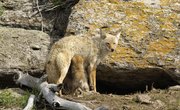How to ID Beaver Poop. If you're hiking around steams or wooded areas you should be able to identify beaver scat, especially if you plan on drinking local water. While generally hard to find, there are a few tell-tale signs by which you can identify beaver droppings.
Step 1
Check the location. The most distinct characteristic of beaver scat is where you find it. Since beaver droppings are usually deposited in the water or underground in one of their elaborate burrows, your chances of seeing beaver scat on dry land are slim. The most likely place you will see the droppings is on the water's edge, at the side of a stream or a riverbank.
Step 2
Look at the shape and size. Look for small, cylindrical scat, about 1.5- to 2.5-inches long. Most of the visible scat will be hardened, as beavers re-ingest their soft droppings the way that rabbits do.
Step 3
Note the texture and composition. Visible beaver droppings are usually dry, since the scat that beavers leave on the water's edge is the hard variety that tends to dry out quickly. Touch the scat with a stick and try to break it apart. If the scat turns out to have a sawdust-like appearance and texture then it is likely to be beaver droppings.
Step 4
Look for other signs of the beaver. Watch for beaver tracks, which show a larger webbed hind foot and a much smaller front foot, each with five toes. Search for a beaver burrow close to the water. If you find a burrow, you can pull some of the scat out from deep inside it with a stick to compare the droppings inside the burrow with your scat specimen.
Writer Bio
This article was written by the CareerTrend team, copy edited and fact checked through a multi-point auditing system, in efforts to ensure our readers only receive the best information. To submit your questions or ideas, or to simply learn more about CareerTrend, contact us [here](http://careertrend.com/about-us).


